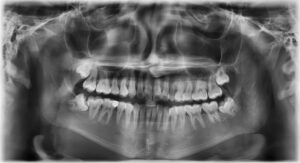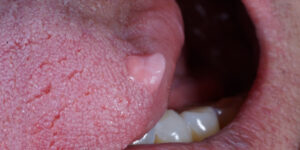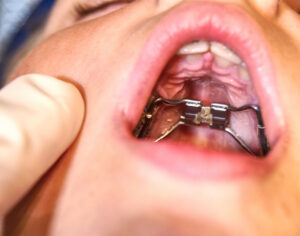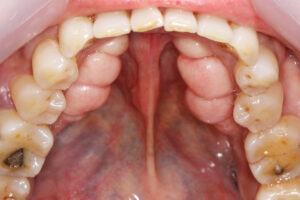Services offered
Below is a summary of the services we offer. If you have more questions please contact us by phone 972-296-29621 or with our contact form.
Surgical removal of teeth that are causing pain or other dental problems.

Surgical removal of impacted and erupted teeth is a common procedure in oral surgery that involves the removal of teeth that are partially or fully trapped within the jawbone or soft tissues. Impacted teeth are teeth that have failed to fully emerge from the gums, often due to being blocked by other teeth or lack of space in the jaw. Erupted teeth, on the other hand, have fully emerged from the gums but may still need to be removed for various reasons such as to create space for orthodontic treatment or because they are damaged or infected.
Surgical removal of impacted and erupted teeth is typically performed under local anesthesia or general anesthesia, depending on the complexity of the procedure and the preference of the patient. The surgeon will make an incision in the gums to access the tooth and may need to remove surrounding bone tissue to fully expose the tooth. Once the tooth is visible, the surgeon may need to break it into smaller pieces to remove it. In some cases, the surgeon may need to stitch the gum tissue back together after the tooth has been removed.
After the procedure, the patient will be given instructions for caring for the surgical site and managing any pain or discomfort. Pain medication and antibiotics may be prescribed, and the patient may need to follow a special diet and avoid certain activities for a period of time to promote healing. In some cases, a follow-up appointment may be scheduled to ensure that the surgical site is healing properly.
Dental implants are medical devices surgically implanted into the jaw to restore a person’s ability to chew or their appearance

Biopsies of the mouth, tongue, or lips take a sample cells or tissues for examination to determine the presence or extent of a disease
An orthodontic technique that is used to expand the maxillary arch.

Rapid palatal expansion (RPE) surgery is a type of oral surgery used to widen the upper jaw (maxilla) in patients with a narrow palate. This surgery is typically performed on children and adolescents, although it can also be performed on adults in some cases.
RPE surgery is used to treat a variety of dental and orthodontic issues, including:
- Crowding of the teeth
- Crossbite (when the upper teeth fit inside the lower teeth)
- Breathing problems due to a narrow airway
- Snoring or sleep apnea
During RPE surgery, a small device called a palatal expander is attached to the upper teeth and slowly widened over a period of weeks or months. This causes the palatal bones to gradually separate, creating more space in the upper jaw. In some cases, the palatal expander may be turned using a special key, allowing the patient or their parent to adjust the device at home.
A procedure to expose a tooth or teeth partially trapped beneath the gums. Wisdom teeth and canine teeth are the most common teeth to become impacted, but any tooth can be affected.

Tori removal is a type of oral surgery that involves the removal of a bony growth known as a torus (or tori, if there are multiple growths) from the upper or lower jaw of a patient. Tori are typically benign, non-cancerous growths that are composed of normal bone tissue.
Tori can develop in a variety of shapes and sizes, and their presence in the mouth can sometimes cause discomfort or difficulty with speech or chewing, especially if they are large or interfere with the placement of dental prosthetics such as dentures.
Tori removal is usually performed by an oral surgeon or a dentist with training in oral surgery, using local anesthesia to numb the area and a surgical instrument to remove the torus. After the torus has been removed, the surgeon may use sutures to close the incision and promote healing. The patient may be given pain medication and instructions for caring for the surgical site during the recovery period.
Pre-prosthetic surgery is a type of oral surgery that is performed to prepare a patient’s mouth for the placement of dental prosthetics, such as dentures or dental implants. The goal of pre-prosthetic surgery is to ensure that the mouth is healthy and that the prosthetic can be securely and comfortably fitted in the mouth.
Pre-prosthetic surgery may involve a range of procedures, depending on the specific needs of the patient. Some of the most common pre-prosthetic surgical procedures include:
- Bone grafting: If a patient’s jawbone is too thin or has deteriorated due to periodontal disease or tooth loss, a bone graft may be performed to add bone to the area and create a more stable foundation for dental implants or dentures.
- Soft tissue grafting: If a patient has thin or receding gums, a soft tissue graft may be performed to add tissue to the area and create a more stable base for dental prosthetics.
- Ridge augmentation: If a patient’s jawbone is uneven or has an irregular shape, a ridge augmentation may be performed to reshape the bone and create a more stable base for dental prosthetics.
- Tooth extraction: If a patient has damaged or decayed teeth that cannot be saved, they may need to be extracted before dental prosthetics can be placed.
Crown lengthening is a type of oral surgery that involves the removal of gum tissue and/or bone to expose more of a tooth’s surface, typically to prepare the tooth for a dental restoration such as a crown or bridge. The goal of crown lengthening is to create more space between the crown of the tooth and the gum line, allowing for a more secure and aesthetically pleasing restoration.
Crown lengthening is typically performed under local anesthesia, although sedation may be used for patients with dental anxiety or for more complex procedures. The surgeon will make a small incision in the gum tissue and use specialized instruments to remove small amounts of gum tissue and/or bone. Once enough of the tooth’s surface has been exposed, the incision is closed with sutures.
After the procedure, the patient may experience some discomfort, swelling, and sensitivity to hot and cold temperatures. Pain medication and antibiotics may be prescribed, and the patient may need to follow a special diet and avoid certain activities for a period of time to promote healing. In some cases, the patient may need to return for a follow-up appointment to ensure that the surgical site is healing properly.